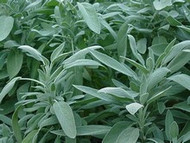How To Grow Sage
Sage is very slow to establish itself, so be prepared for a wait if you grow it from seed. When established however, common sage is reasonably hardy and tolerant of almost all conditions as long as it receives a regular dose of full sun.
It is well suited to growing in containers and will grow indoors if given sufficient light. Add to this the nicely textured velvet grey-green leaves and violet flowers and you have a herb or flowering plant well-suited to all gardeners.
There are several varieties of sage with different coloured flowers and even variegated leaves (some fine for kitchen use), although none are as hardy as the common sage.
Where To Grow
Sage will grow almost anywhere as long as it is in full sun for a good part of the day. The best soil is a well-dug medium one, with a handful or two of bonemeal worked in twice during the summer. What sage does not like is soil that is moist all the time - it is a native of Mediterranean areas
Propagating
Sage is sold at most garden centres in small pots - as long as they are purchased after all danger of frost has passed, they can be planted straight outside. This is the quickest and most reliable way to start growing sage. Make sure that a 90cm (3ft) is in place near the main stem - the plant can be tied to it as it grows. Sage can stand by itself most of the time, but the odd strong wind may snap the brittle woody stem. You should be able to pick a few leaves in July time if planted in Spring.
It is more satisfying to raise sage from seed, but be prepared to wait. Sow indoors in March (potting compost is fine), or in April outside. The plants will grow very slowly and you will only be able to begin harvesting in Junethe next year.
Sage looses some of its strength after three or four years, so it is necessary to take cuttings in Spring (5cm or 2in long) to replace the plant the next year.
Container Growing
For simplicity itself - use potting compost (remember to put a good layer of stones at the bottom for drainage) and keep the plant on the dry side throughout it's life. A feed every month with general purpose liquid plant food will be enough. Prune as described above.
Sage can be grown indoors as long as it is placed on a sunny windowsill - it will stand direct sunlight with no problems.
Recommended Sage Varieties
Choosing a variety of sage is a matter of personal taste. However, for starters, shown below are a few tried and trusted varieties.
Sage Salvia officinalis Icterina - variegated leaves and lilac blue flowers as well as being ideal as the traditional herb sage.
Purple Sage Salvia officinalis Purpurascens - great for use as the traditional sage herb, but also with purple foliage.
Sage Salvia officinalis - as the Latin name implies, this is the original sage used for centuries to flavour stuffing, meats and even make sage tea.
